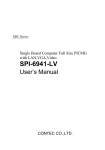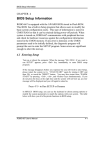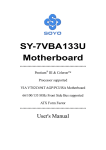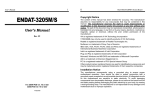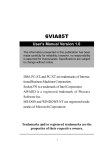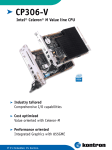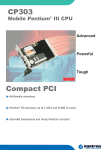Download Introduction Introduction
Transcript
Introduction CHAPTER 1 Introduction The ROBO-667 all-in-one single board computer is designed to fit a high performance Pentium-III based CPU and compatible for high-end computer system with PCI/ISA Bus architecture. It is made to meet today’s demanding pace, and keep complete compatibility with hardware and software designed for the IBM PC/AT. It is beneficial to build up a high performance system for VARs, or system integrators. The on-board 3D Graphics display, and fast Ethernet interface will bring full functionality and high performance to all segments of the industrial PC market. This single board computer runs with dual Intel Pentium-III (FC-PGA & FCPGA2) processors, and supports DIMM up to 1.5 GB SDRAM. The enhanced on-board PCI IDE interface can support 4 drives up to PIO mode 4 timing and Ultra DMA/33/66/100 synchronous mode feature. The onboard Super I/O integrates one floppy controller, two serial ports, one keyboard controller, one hardware monitor, one IrDA port and one parallel port. Two high performance 16C550-compatible UARTs provide 16-byte transmit/receive FIFOs, and the multi-mode parallel port supports SPP/EPP/ECP function. Besides, three USB (Universal Serial Bus) ports provide high-speed data communication between peripherals and PC. PCI type daughter board can also be compatible to ROBO-667. The PICMG standard makes the ROBO-667 work with the legacy ISA, ISA/PCI or multi-slots PCI-bus backplane. The on-board 32-pin DIP socket supports M-systems DiskOnChip 2000 product up to 288MB. The WatchDog Timer function can be used to monitor your system status. One 6-pin Mini-DIN connector (with Y-Cable) is provided to connect PS/2 Mouse and Keyboard. The on-board Flash ROM is used to make the BIOS update easier. Two standard 5-1/4” drive power connectors are reserved to directly get more power energy for big power applications, and the additional 5-pin shrouded connector is reserved for connecting Keyboard interface on the backplane. One 4-pin header is designed to support ATX ROBO-667 User’s Manual 1-1 Introduction power function. All of these features make ROBO-667 excellent in standalone applications. 1-1 Check List The ROBO-667package should cover the following basic items accompany with this manual. • One ROBO-667 single board computer • One Parallel Port cable kit • One Serial Port cable to support two interfaces • One FDC cable • One IDE cable • One Y-Cable cable for PS/2 Keyboard and Mouse • One 5-pin to 5-pin keyboard cable for backplane connection • One 4-pin ATX power control cable for backplane connection • One CD of ROBO-667 drivers with electronic version user’s manual • One quick installation guide If any of these items is damaged or missing, please contact your vendor and keep all packing materials for future replacement and maintenance. ROBO-667 User’s Manual 1-2 Introduction 1-2 Product Specifications • Main processor Dual Intel Pentium-III processors CPU bus frequency : 66/100/133 MHz Standard socket 370 for FC-PGA/FC-PGA2 CPU (No support for Celeron) • BIOS Award system BIOS with 4Mb flash ROM to support DMI, PnP, APM, and ACPI • Main Memory Three 168-pin DIMM sockets, supporting PC133/PC100 SDRAM up to 1.5GB (ECC and Registered DIMM Supported) • L2 Cache Memory 256KB/512KB built in Pentium-III/ Pentium-III-S processor • Chipset VIA Apollo Pro133T Chipset • Bus Interface Follow PICMG 1.0 Revision 2.0 standard (32-bit PCI and 16-bit ISA) Fully complies with PCI Local Bus specification V2.1 (support 4 master PCI slots) • PCI IDE Interface Support two enhanced IDE ports up to four HDD devices with PIO mode 4 and Ultra DMA/33/66/100 mode transfer and Bus Master feature • Floppy Drive Interface Support one FDD port up to two floppy drives and 5-1/4"(360K, 1.2MB), 3-1/2" (720K, 1.2MB, 1.44MB, 2.88MB) diskette format and 3-mode FDD • Serial Ports Support two high-speed 16C550 compatible UARTs with 16-byte T/R FIFOs • IR Interface Support one 6-pin header for serial Standard Infrared wireless communication ROBO-667 User’s Manual 1-3 Introduction • Parallel Port Support one parallel port with SPP, EPP and ECP modes • USB Interface USB 1.1 support three ports for high speed I/O peripheral devices • PS/2 Mouse and Keyboard Interface Support one 6-pin Mini-DIN connector and one 5-pin shrouded connector for PS/2 mouse/keyboard connection through Y-Cable and backplane connection • ATX Power Control Interface One 4-pin header to support ATX power control with Modem Ring-On and Wake-On-LAN function • Auxiliary I/O Interfaces System reset switch, external speaker and HDD active LED • Real Time Clock/Calendar (RTC) Support Y2K Real Time Clock/calendar with battery backup for 7-year data retention • Watchdog Timer Support watchdog timer from 0.5 to 64 sec. by hardware count & software trigger • Disk-On-Chip (DOC) Feature Reserved one 32-pin socket for M-systems Flash Disk up to 288MB DOS, Windows, Win95, NT (bootable) drivers and Utility supported • On-board VGA ATI Rage Mobility M/M1 with 4MB/8MB SDRAM • On-board Ethernet LAN Intel 82559 LAN controller to support RJ-45 interface at 10/100 Base-T speed • On-board 68-pin PCI device connector Support one additional PCI device daughter board • High Driving Capability Support 64mA high driving capability for multi-slots ISA-bus ROBO-667 User’s Manual 1-4 Introduction • External Power Connector Support two standard 5-1/4” disk drive power connectors to enhance power driving • CPU Cooling Fan Support two 3-pin headers with wafer • System Monitoring Feature Monitor CPU and system temperature, operating voltage, and fan status • Bracket Support one Mini-DIN, one-port USB, one Ethernet port and one VGA port • Physical and Environmental Requirements Outline Dimension (L X W) : 338.5mm (13.33”) X 122mm (4.8”) PCB layout : 8 layer Power Requirements : +5V @15A , +12V @200mA Operating Temperature : 0°C ~ 55°C ( 32°F ~ 131°F ) Storage Temperature : -20°C ~ 75°C Relative Humidity : 5% 〜 95%, non-condensing ROBO-667 User’s Manual 1-5 Introduction 1-3 System Architecture The following illustration will show you how ROBO-667 gives you a highly integrated system solution. The most up-to-date system architecture of ROBO-667 includes three main VLSI chips, VIA VT82C694T,VT82C686B and ATI Rage-Mobility M/M1, to support Pentium-III (FC-PGA/FC-PGA2) processor, SDRAM, 3D graphic display, PCI bus interface, APM, ACPI compliant power management, USB port, SMBus communication, Ultra DMA/33/66/100 IDE Master, PS/2 Keyboard/Mouse, two UARTs, FDC, Hardware Monitor, Parallel, Watch Dog Timer and Infrared interface. Besides, Intel 82559 LAN controller provides a competitive fast Ethernet function. The CPU socket adopts the Socket-370 type to support high availability, reliability, and easy operation in general industry application. The VT82C694T provides an integration of memory controller and graphics capability (AGP). It combined with AGP 2X ATI VGA chip provides highest effect/cost ratio for 3D textures and MPEG-2 hardware decoding solutions. Its 64-bit AGTL+ based host bus interface, optimized 64-bit DRAM interface supports three 3.3V DIMMs at the maximum bus frequency of 100/133 MHz. The 32-bit PCI bus interface supports 4 PCI masters for external backplane support. The VT82C686B supports 2-channel dedicated Ultra DMA-33/66/100 IDE master interfaces, full Plug-and-Play compatibility, APIC (Advanced Programmable Interrupt Controller) interface, and internal real-time clock (RTC) to maintain time and date of a system. It also supports 3-port USB (Universal Serial Bus feature) and PCI 2.1 Compliance operation. It fully supports Operating System Directed Power Management via the Advanced Configuration and Power Interface (ACPI) specification. In addition, it also integrates two high-speed serial ports, one parallel port, SIR interface, H/W monitoring, FDD interface and 8042 keyboard controller with PS/2 mouse ports. This parallel port supports one PC-compatible printer port (SPP, bidirection), Enhanced Parallel Port (EPP) and Extended Capabilities Port (ECP). Watch Dog Timer can be enabled by jumper settings. ROBO-667 supports DiskOnChip (DOC) for M-system flash disk. There is one on-board Intel 82559 PCI Fast Ethernet via RJ-45 Ports to support full functionality of ROBO-667 AIO SBC (All-In-One Single Board Computer). The on-board 68-pin PCI connector supports additional daughter board for further support. ROBO-667 User’s Manual 1-6 Introduction All of details of operating relations are shown in Figure 1-1 ROBO-667 System Block Diagram. Figure 1-1 ROBO-667 System Block Diagram ROBO-667 User’s Manual 1-7







